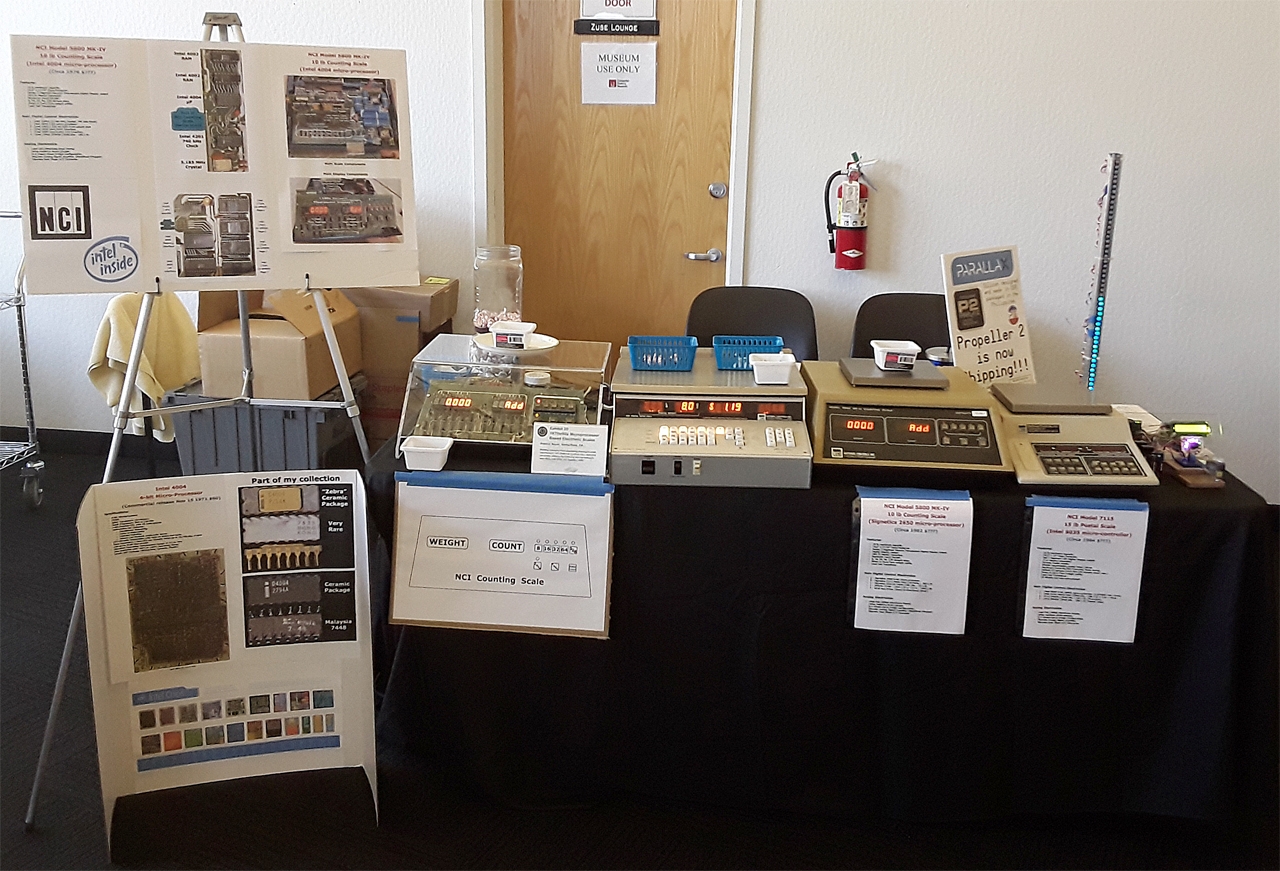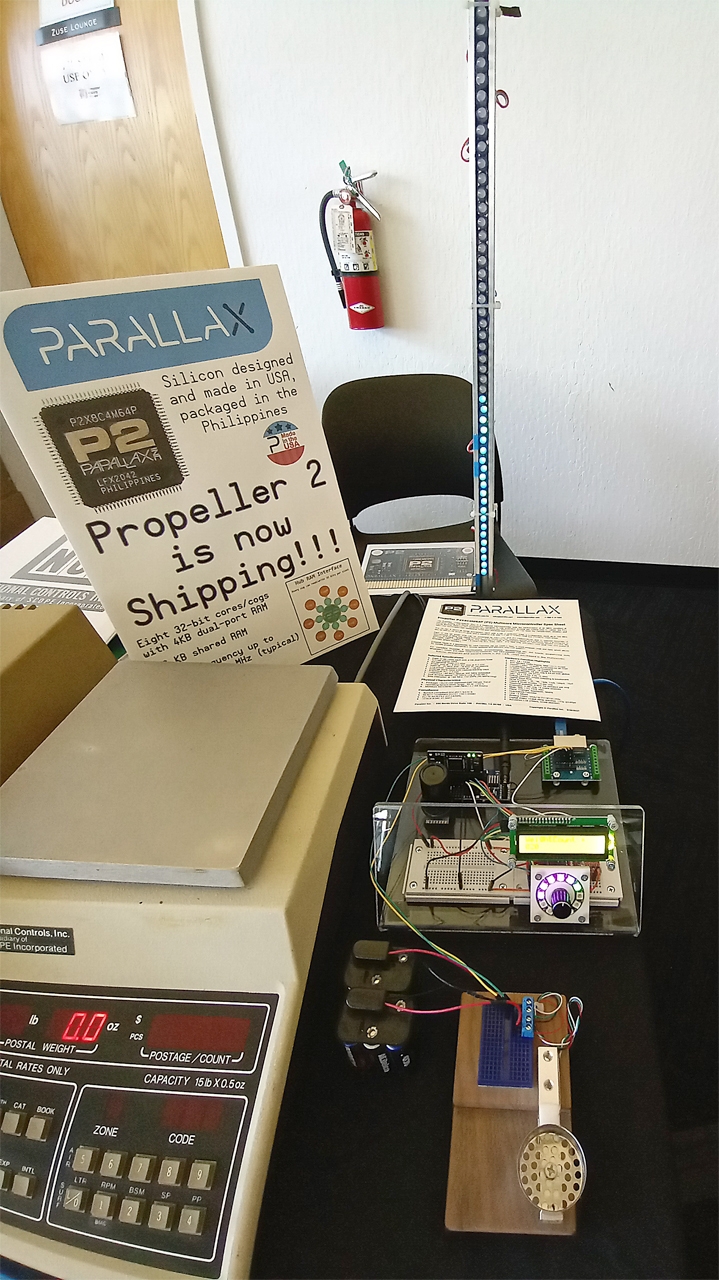Recent Vintage Computer Federation West Festival
 Francis Bauer
Posts: 383
Francis Bauer
Posts: 383
I had a great time over the weekend at the Vintage Computer Federation West festival. I exhibited my collection of NCI Electronic Scales that utilize various Microprocessors. My exhibit included two scales that use Intel 4004 4-bit Microprocessors (50 years old in 2021). These two scales were made in the mid 1970’s. There aren’t too many commercial products still running that use an Intel 4004, so those two scales are very special to me, especially since I used to work for NCI (1977-79).
There were probably at least a 100+ people who stopped and viewed my exhibit over the 2-days. One visitor apparently is a one of Chip’s neighbors; unfortunately I don’t remember his name after talking with all the others over the two days.
As part of my exhibit I included a Demo of how a Strain-Gauge Load Cell Transducer works to convert weight/Mass to a voltage, suitable for conversion using A/D’s.
I took the opportunity to use a Parallax P2 Edge Demo board setup for the Load Cell demonstration to further the P2’s availability to like-minded Electronic & Computer enthusiasts. I was able to hand out at least a dozen P2 Spec sheets to various people who were excited about the abilities of the P2.
There were at least six people who were definitely going to go to the Parallax web-site and check-out the P2. Hopefully this will help generate more sales and excitement about the P2.
A lot of people were impressed with the P2 specs and appreciated the Microprocessor time-line I had displayed in hardware going from a single 740kHz 4-bit Microprocessor to a 8 x 32-bit 300+MHz one.
I've included a few photos of my exhibit.




Comments
Very cool.
Some of those scales look heavy!
I'm curious about the weighing pan connected to the P2 Edge, and how it operates mechanically. Is that some sort of strain gauge you mentioned ?
Yes, the two scales using the Intel 4004 microprocessors (left side of the table) have a metal frame/case and are quite heavy to lift.
I had a plexiglass cover made for one of the scales to allow people to see the insides. The 3rd scale from the left has a newer plastic frame and is considerably lighter; that scale by the way uses a Signetics 2650 8-bit microprocessor.
I've attached an image that shows the internals (and a simplified schematic) of the NCI designed/built Strain Gauge Load Cell (10lb capacity) that is used in the NCI scales. The schematic doesn't show the two additional temperature compensating resistors that are used in the actual Load Cell. The 4 Strain Gauge resistors are "glued" to the horizontal aluminum beam in the middle of the image, where you see the copper wires connected. These Load Cells were assembled by hand using a microscope in order to do the precise soldering. NCI did a lot of "engineering" to perfect the design of their Load Cells. I worked for NCI from 1977-79, my last position was as an Electronic Technician in the Load Cell R&D Engineering department.
As you can see from the simplified schematic, these Load Cells have essentially a "wheat-stone" bridge setup, where you monitor the output voltage that varies as the Load Cell frame is deflected by weight being applied causing the middle aluminum beam to deflect ever so slightly. As the resistance of the Strain Gauge resistors change by being stressed the "wheat-stone" bridge output changes.
NCI also constructed Load Cells using stainless-steel instead of aluminum for larger weight capacities. NCI made Load Cells capable of measuring weights over a wide range of capacities; some in excess of 10,000 lbs to be used in Truck scales and other platform scale applications.
The simple "beam" Load Cell that I have connected to the P2 is a "cheapo" (1kg) one that I got for playing around with. The "cheapo" Load Cell has a similar electrical setup as the NCI ones, but I'm sure they don't have the temperature compensating resistors to improve the accuracy of the device when used over a range of temperatures.
In my P2 Demo I'm supplying 18vdc as the excitation voltage to the Load Cell and directly reading the output on a single A/D P2 pin. There is enough of a output voltage from the Load Cell to be seen by the P2, but I should ideally have used an amplifier to boost the Load Cell output to get a better signal range.
The hand assembly is incredible when considered with the accuracy requirements. I wonder how close to the mark these things ran before calibration- I can imagine that being "the challenge" amongst the assembly team!
Good to know about.
I confess I might have been here the first to know about the VCW West events, because I receive email from the VCF crowd, and participate in most of their activities. That includes, (will include or has included) their repair weekends. And of course I'll be at their VCF East event in October.
Oh and you might have seen wandering about, a tall fellow wearing an outfit that looked more out of place then usual. He wore an outfit that made some people think of an aging (and badly) pop star, and walking with a young lady, who called him "Doctor".
Mascot present but not involved, robots working but not down here.
Very cool! I see it was in Mountain View: https://vcfed.org/wp/
A bit far from LA, if it was closer and I had known, I would have been tempted to go. I inherited my Dad's IMSAI 8080 a few years ago. Haven't touched it yet, I would need a kick in the butt and a month-plus deadline for motivation.
Someday!